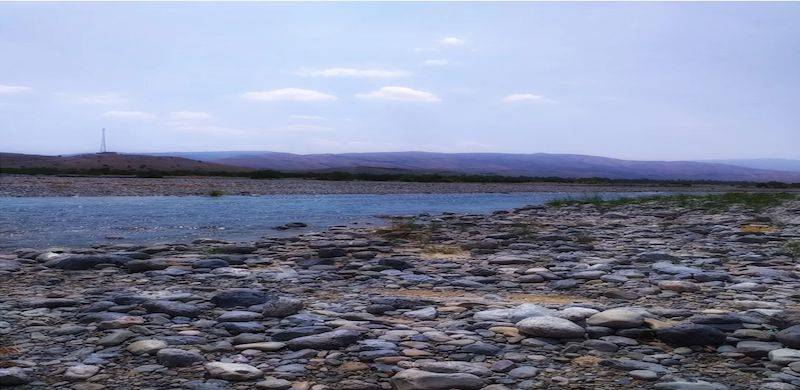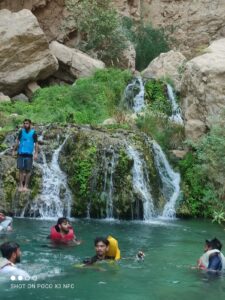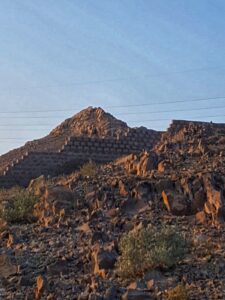
“If this is your first adventure trip in Pakistan, we suggest you go for something lighter and easier – like Ormara Beach. Not Moola Chotok – since that is the most challenging of all our adventure trips''. This was one of the first things we were told by the tour operator we partnered with, Rover Adventure Club Pakistan (RAC).
On the personal front, our families had one significant concern: security. Why we would want to visit Balochistan, given its largely absent civic infrastructure and amenities was something beyond their comprehension. None of this is anything anyone would want to hear, when they have their hearts set on something – but I decided to go with it. And truth be told, there were no regrets in traversing an area that most people have yet to experience.
Moola Chotok is said to have a hidden ravine located in the middle of the Khuzdar District in Balochistan – located some 105 kilometers (65 mi) north-east of Khuzdar at an elevation of 1,237 meters (4,058 ft).
Surrounded by tall cliffs, the cascading waterfall is one of the biggest in Sub Tehsil Moola and is called the Chotok. Before we were due to travel, I did a quick fact check and came up with some pretty interesting insights.

As a sub-tehsil, Moola is said to be home to the Hidden Saint – where locals built a shrine for Pir Chattal, the biggest pir of Balochistan at one of the water pools in the area. The fish harboring these pools swim back and forth from the shrine as if to protect it. Legend has it that the fish belong to the pir and that if anyone were to eat or harm even one, it would come out of their bodies alive. I wonder if the fish we saw at the waterfalls are the same fish this legend reveres so greatly.
Given the off roaders’ experience that RAC had promised us, the route we took was comparatively shorter, but completely unpaved (approximately) 90 km-long dirt and rock track near the intersection of RCD and M-8. The other option would have been the longer (but saner and safer) route through Karakh town of Khuzdar District using the near completion M-8 Ratodero-Gawadar Motorway.
M-8 aims to be a life-changing infrastructure project for many, comparable to what the Makran Coastal Highway has achieved in Ormara, Pasni and Gawadar. But ours was an adventure experience at stake and RAC delivered exactly that.
So, what we assumed would have been 3-4 hours turned out to be a day-long trip of grueling offroading on dirt, rocky patches and random streams. Several times, our driver would have to check how deep these streams were to ensure our 4x4 could make it through them; there were times when our vehicle would literally be angled at 45 degrees.
Several times during the journey, we lost sight of the other 4x4’s on our entourage – convincing us that our driver had lost the way and was working on a trial and error methodology. Scary, indeed!

But the site that awaited us, was nothing short of being unbelievably spectacular and is known mostly for the water falling from and out of stones, rocks and the two mountains. Visitors will experience several different water bodies featured at Moola Chotok: random puddles, streams and waterfalls gushing out of the rocky walls and waterslides smoothened by years and years of water erosion.
Our guides from RAC suggested we do the smaller waterfall before moving to its larger counterpart. They explained that over time, water volume at the main waterfall had gone down; whether this was a seasonal phenomenon or caused by waterslides and / or human intervention is something I forgot to ask. They further explained that the smaller waterfall had somehow maintained its water levels and we decided to go with their word. Given that we had one night in the great outdoors, we left our visit to the bigger waterfall to the next day – entirely at our discretion.
During our trip, our aim was to reach the point where the water originated from and return safely. So, on and on we prodded, waded, jumped, swam and climbed against the flow to get a closer view. Something unique we experienced was the origin of the water: which remains cold in summer and warm in winter, making it one of the biggest paradoxes of nature.
For someone with not even the most elementary trekking experience, this was quite the adventure for me, and my thoughts did revert to what we were initially told: to go for something easier than "Moola Chotok". Not one to back down, though, I did as much as I could and cannot thank our tour guides enough for all the (literal and actual) hand holding they provided on my way up and down the falls.
The reading I engaged in before our trip, showed that Moola (as a sub tehsil) has a strong strategic / geographic importance and historical background – apart from its aesthetic beauty. As the shortest distance between central Balochistan and Sindh and the gateway between central and west Balochistan, Sindh and Iran – the Moola Pass is often the choice route for travelers on this path.
Ruins of several civilizations including Thore khear, Hatachi, Hayrav, Kial Beig and Pasta Khan trace their lineage belonging to the 2000-year-old history of Moola. Getting to Moola involves travelling through Khuzdar and interestingly, Khuzdar appears as Khnenta in the Zend Avesta or Zoroastrianism and is one of the sixteen beautiful lands created by Ahura Mazda – meaning that the region traces its roots to their scriptures! So according to the sixteen perfect lands created by Ahura Mazda, and as many plagues created by Angra Mainyu:
“The ninth of the good lands and countries which I, Ahura Mazda,created, was Khnenta which the Vehrkanas inhabit. Thereupon came Angra Mainyu, who is all death, and he counter-created a sin for which there is no atonement, the unnatural sin.”
Balochistan is completely synonymous with political instability, insurgency, civil unrest, deprivation, poverty and so much more; but, little did we know that the province is home to more than the sum of all those adjectives.
With tourism on the rise, we know about Kund Malir, Hingol National Park and the sphinx located there. Our guides from RAC mentioned that Moola Chotok came into prominence some five years ago and can, hence, not really be described as hidden anymore – since it is slowly attracting tourists of all ages.
Everyone knows about Baluchistan is home to the only deep sea port in Gwadar and the province being rich in natural resources including coal, chromite, marble, iron ore – among others. Ironically, though, not once during our trip did we feel unsafe or insecure.
This could possibly be because of how RAC handled and executed our trip (which left us completely bowled over). Or it could be because we were completely immersed in the full experience of our trip – leaving us with no time to think about security concerns.
They say the journey of a thousand miles starts with that first step. And as I now recall my weekend getaway to Moola Chotok, I felt that in dealing with my life’s (every day) small stuff, I often miss the bigger picture. Being able to indulge in an (otherwise) once in a lifetime experience, I realised I was able to connect with something bigger than myself.
And this, perhaps, is what Maulana Jalaludin Rumi meant when he said:
“You show your worth by what you seek.”
On the personal front, our families had one significant concern: security. Why we would want to visit Balochistan, given its largely absent civic infrastructure and amenities was something beyond their comprehension. None of this is anything anyone would want to hear, when they have their hearts set on something – but I decided to go with it. And truth be told, there were no regrets in traversing an area that most people have yet to experience.
Moola Chotok is said to have a hidden ravine located in the middle of the Khuzdar District in Balochistan – located some 105 kilometers (65 mi) north-east of Khuzdar at an elevation of 1,237 meters (4,058 ft).
Surrounded by tall cliffs, the cascading waterfall is one of the biggest in Sub Tehsil Moola and is called the Chotok. Before we were due to travel, I did a quick fact check and came up with some pretty interesting insights.

As a sub-tehsil, Moola is said to be home to the Hidden Saint – where locals built a shrine for Pir Chattal, the biggest pir of Balochistan at one of the water pools in the area. The fish harboring these pools swim back and forth from the shrine as if to protect it. Legend has it that the fish belong to the pir and that if anyone were to eat or harm even one, it would come out of their bodies alive. I wonder if the fish we saw at the waterfalls are the same fish this legend reveres so greatly.
Given the off roaders’ experience that RAC had promised us, the route we took was comparatively shorter, but completely unpaved (approximately) 90 km-long dirt and rock track near the intersection of RCD and M-8. The other option would have been the longer (but saner and safer) route through Karakh town of Khuzdar District using the near completion M-8 Ratodero-Gawadar Motorway.
M-8 aims to be a life-changing infrastructure project for many, comparable to what the Makran Coastal Highway has achieved in Ormara, Pasni and Gawadar. But ours was an adventure experience at stake and RAC delivered exactly that.
So, what we assumed would have been 3-4 hours turned out to be a day-long trip of grueling offroading on dirt, rocky patches and random streams. Several times, our driver would have to check how deep these streams were to ensure our 4x4 could make it through them; there were times when our vehicle would literally be angled at 45 degrees.
Several times during the journey, we lost sight of the other 4x4’s on our entourage – convincing us that our driver had lost the way and was working on a trial and error methodology. Scary, indeed!

But the site that awaited us, was nothing short of being unbelievably spectacular and is known mostly for the water falling from and out of stones, rocks and the two mountains. Visitors will experience several different water bodies featured at Moola Chotok: random puddles, streams and waterfalls gushing out of the rocky walls and waterslides smoothened by years and years of water erosion.
Our guides from RAC suggested we do the smaller waterfall before moving to its larger counterpart. They explained that over time, water volume at the main waterfall had gone down; whether this was a seasonal phenomenon or caused by waterslides and / or human intervention is something I forgot to ask. They further explained that the smaller waterfall had somehow maintained its water levels and we decided to go with their word. Given that we had one night in the great outdoors, we left our visit to the bigger waterfall to the next day – entirely at our discretion.
During our trip, our aim was to reach the point where the water originated from and return safely. So, on and on we prodded, waded, jumped, swam and climbed against the flow to get a closer view. Something unique we experienced was the origin of the water: which remains cold in summer and warm in winter, making it one of the biggest paradoxes of nature.
For someone with not even the most elementary trekking experience, this was quite the adventure for me, and my thoughts did revert to what we were initially told: to go for something easier than "Moola Chotok". Not one to back down, though, I did as much as I could and cannot thank our tour guides enough for all the (literal and actual) hand holding they provided on my way up and down the falls.
Balochistan is completely synonymous with political instability, insurgency, civil unrest, deprivation, poverty and so much more; but, little did we know that the province is home to more than the sum of all those adjectives.
The reading I engaged in before our trip, showed that Moola (as a sub tehsil) has a strong strategic / geographic importance and historical background – apart from its aesthetic beauty. As the shortest distance between central Balochistan and Sindh and the gateway between central and west Balochistan, Sindh and Iran – the Moola Pass is often the choice route for travelers on this path.
Ruins of several civilizations including Thore khear, Hatachi, Hayrav, Kial Beig and Pasta Khan trace their lineage belonging to the 2000-year-old history of Moola. Getting to Moola involves travelling through Khuzdar and interestingly, Khuzdar appears as Khnenta in the Zend Avesta or Zoroastrianism and is one of the sixteen beautiful lands created by Ahura Mazda – meaning that the region traces its roots to their scriptures! So according to the sixteen perfect lands created by Ahura Mazda, and as many plagues created by Angra Mainyu:
“The ninth of the good lands and countries which I, Ahura Mazda,created, was Khnenta which the Vehrkanas inhabit. Thereupon came Angra Mainyu, who is all death, and he counter-created a sin for which there is no atonement, the unnatural sin.”
Balochistan is completely synonymous with political instability, insurgency, civil unrest, deprivation, poverty and so much more; but, little did we know that the province is home to more than the sum of all those adjectives.
With tourism on the rise, we know about Kund Malir, Hingol National Park and the sphinx located there. Our guides from RAC mentioned that Moola Chotok came into prominence some five years ago and can, hence, not really be described as hidden anymore – since it is slowly attracting tourists of all ages.
Everyone knows about Baluchistan is home to the only deep sea port in Gwadar and the province being rich in natural resources including coal, chromite, marble, iron ore – among others. Ironically, though, not once during our trip did we feel unsafe or insecure.
This could possibly be because of how RAC handled and executed our trip (which left us completely bowled over). Or it could be because we were completely immersed in the full experience of our trip – leaving us with no time to think about security concerns.
They say the journey of a thousand miles starts with that first step. And as I now recall my weekend getaway to Moola Chotok, I felt that in dealing with my life’s (every day) small stuff, I often miss the bigger picture. Being able to indulge in an (otherwise) once in a lifetime experience, I realised I was able to connect with something bigger than myself.
And this, perhaps, is what Maulana Jalaludin Rumi meant when he said:
“You show your worth by what you seek.”

